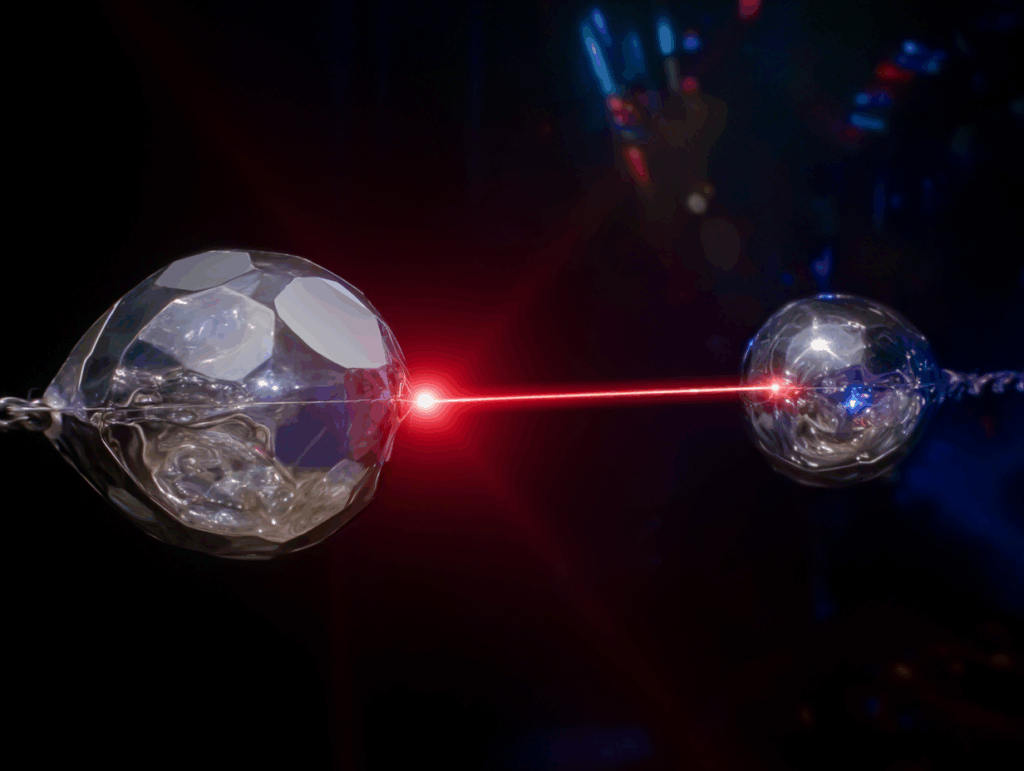 Credit: Midjourney/ZME Science.
Credit: Midjourney/ZME Science.
Every message we send online, whether a bank transfer or a meme, relies on light. Tiny pulses travel through fiber-optic cables, bouncing between nodes that amplify the signal every few dozen kilometers. Your internet might come from your wireless carrier or WiFI, but broadband’s backbone is still fiber-optic cables. But the quantum internet of the future — an ultra-secure network based on the principles of quantum mechanics — can’t rely on this same infrastructure.
Or so we thought.
Now, physicists at the University of Stuttgart have achieved something long thought nearly impossible. They teleported quantum information between photons emitted by two different light sources. The experiment brings the dream of a working quantum internet a crucial step closer.
“For the first time worldwide, we have succeeded in transferring quantum information among photons originating from two different quantum dots,” said Prof. Peter Michler, who led the study at Stuttgart’s Institute of Semiconductor Optics and Functional Interfaces.
The Quantum Leap
 Physicists from research groups at the University of Stuttgart, Saarbrücken, and Dresden conducting an experiment on quantum teleportation. Credit: Julian Maisch
Physicists from research groups at the University of Stuttgart, Saarbrücken, and Dresden conducting an experiment on quantum teleportation. Credit: Julian Maisch
In today’s digital networks, light signals carrying ones and zeros are regularly boosted by amplifiers. But in quantum communication, any attempt to copy or amplify information would destroy it. Instead, information must be teleported, in the sense that it must be transferred from one particle to another without physically moving it, through a process based on quantum entanglement.
Quantum teleportation isn’t teleportation in the sci-fi sense. No material is jumping through space. What moves is the quantum state, a particle’s unique set of physical properties like its spin.
In the Stuttgart experiment, the researchers used two semiconductor quantum dots. Think of these as nanoscopic “islands” that emit single photons with precisely controlled properties. One dot produced a lone photon carrying information; the other generated an entangled pair. Entanglement links two particles so their properties remain connected, even across vast distances.
Using a technique known as a Bell state measurement, the team interfered one photon from the entangled pair with the photon from the first quantum dot. This caused the information encoded in the first photon’s polarization — the direction of its light wave — to be teleported to the remaining photon in the pair.
“Light quanta from different quantum dots have never been teleported before because it is so challenging,” said Tim Strobel, the study’s first author.
This achievement required the photons to be indistinguishable, with the same color and timing. Normally, photons from different quantum dots vary slightly in wavelength or emission pattern. The team overcame this by using quantum frequency converters developed by collaborators at Saarland University, which adjusted each photon’s frequency so they matched perfectly.
Building the Quantum Internet’s Backbone
 The quantum teleportation setup. Credit: Nature Communications (2025).
The quantum teleportation setup. Credit: Nature Communications (2025).
The experiment went further than simply showing teleportation between two photons. The researchers performed the entire procedure using telecommunication wavelengths, the same kind of light used in the world’s fiber-optic networks.
As detailed in the paper’s diagrams, each photon’s path ran through quantum frequency converters that shifted their wavelength from about 780 nanometers to 1,515 nanometers, the standard for telecom cables. This means that, in principle, the technology could be integrated into existing infrastructure with minimal modification.
“Transferring quantum information between photons from different quantum dots is a crucial step toward bridging greater distances,” Michler explained.
In their lab, the team connected the two quantum dots with a 10-meter optical fiber. That’s short by internet standards, but prior work by the same group has already shown that entanglement can survive across 36 kilometers of fiber through Stuttgart’s city center.
Their current setup achieved a teleportation fidelity of about 0.72, meaning the transferred quantum state matched the original with 72% accuracy — well above the classical threshold of two-thirds. “A fidelity above 0.67 proves that the process relies on quantum mechanics,” said Strobel.
The researchers also measured how well the photons overlapped when they met, a property known as two-photon interference visibility, and found it reached 30% overall, climbing to nearly 80% in short time windows. These numbers may sound small, but they confirm a stable, repeatable quantum connection between separate sources, which is something no one had done before.
“Achieving this experiment has been a long-standing ambition — these results reflect years of scientific dedication and progress,” said Dr. Simone Luca Portalupi, one of the study’s coordinators. “It’s exciting to see how experiments focused on fundamental research are taking their first steps toward practical applications.”
Why It Matters
A functioning quantum internet could transform cybersecurity and data transmission. Quantum signals are inherently tamper-evident: any attempt to eavesdrop disturbs them, revealing the intrusion. Networks based on quantum teleportation could link quantum computers or enable long-range encrypted communications that are unbreakable by even the most powerful AI systems.
Still, the road ahead is steep. The team’s teleportation worked only over short distances and required precise timing and synchronization. Increasing the range and improving the fidelity — especially without “post-selection” that filters out failed attempts — are the next challenges.
According to the authors, enhancing semiconductor fabrication techniques, reducing spectral noise, and improving photon purity could raise fidelity above 0.85 or even 0.99 in future designs.
But the foundation is there. The photons used were transmitted through standard optical fibers, at telecom wavelengths, and with equipment that could, one day, form the backbone of a secure global quantum web.
In a field where progress often comes one photon at a time, this experiment lights a clear path forward.
“These results demonstrate the maturity of quantum dot-based technology, showing an important building block for future quantum communication,” the researchers conclude in Nature Communications.

